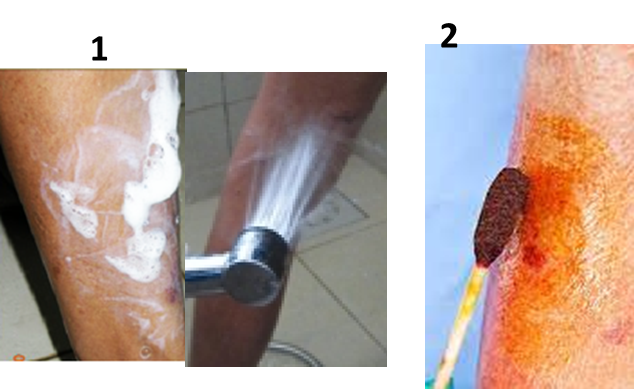1.Immediately wash all the wounds with lots of water and soap. Ensure thorough flushing and that all the wounds are washed.
• Washing with soap and water should be started as soon as possible and continued for 15 minutes.
• Such thorough washing will remove a major amount of virus from the wound.
It is of utmost importance that all the wounds are detected and each one managed.
2.Application of antiseptics: Povidone Iodine or any antiseptic with virucidal activity.
• After thorough washing and drying the wound, apply any virucidal agent like Povidone Iodine, alcohol etc.
If soap and/or antiseptic are not available, wash at least with lots of water. It will flush away the saliva of the biting animal from the wound.
3.Infiltrating RIG locally in the bite wound/s:
The role of RIG infiltration is to provide readymade rabies antibodies at the wound site till the time patient’s own antibodies start developing as an effect of rabies vaccination
Indication of RIG:
• Category III bites
• Category II & III bites in immune-compromised patients
Two types of RIG are available.
1. Equine RIG (ERIG) and
2. Human RIG (HRIG)
The effectiveness of both Equine RIG (eRIG) and Human RIG (hRIG) is similar.
Dose:
• ERIG; 40 mg/Kg body weight
• HRIG; 20 mg/Kg body weight
Steps of RIG administration:
Bring the RIG to room temperature
Using insulin syringe or 2ml/5ml syringe with 25G needle; Puncture the edges of the wound and infiltrate. If the wound is superficial, the base should also be infiltrated as much as anatomically possible.
The amount remaining after wound infiltration is may be given IM as near as possible to other smaller wounds.
Care should be taken to make minimum number of punctures, not to injure any blood vessel or nerve or to cause compartment syndrome, during RIG infiltration.
Caution: Even though anaphylaxis following RIG administration is extremely rare: Keep anaphylaxis management equipment ready before RIG infiltration.
E.g. injection adrenaline, hydrocortisone, oxygen etc.
Skin testing before ERIG or HRIG is no more recommended; keep the emergency drugs and equipment ready.
RIG administration should be done as soon as possible after the bite.
Nevertheless, if seven days have passed after the first dose of rabies vaccine, RIG has no role, even if one or both of the day-3 and day-7 doses have been missed. The antibodies induced by the first dose cover the role of RIG
RIG administration must be followed by a complete schedule of rabies vaccine.
Reference:
1. Government of India, National rabies control programme, National guidelines on rabies prophylaxis, National Centre for Disease Control, 2019, Delhi, India.
2. Government of Himachal Pradesh: GUIDELINES FOR RABIES PROPHYLAXIS AND INTRADERMAL RABIES VACCINATION IN HIMACHAL PRADESH, 2019. Directorate of Health Service, Swasthya Sadan, Kasumpti, Shimla-171009
signs & symptoms of rabies in brief: http://www.ihatepsm.com/blog/signs-and-symptoms-rabies-brief
Categorization of animal bite: http://www.ihatepsm.com/blog/post-%E2%80%93-exposure-prophylaxis-rabies
Steps of immediate wound management in animal bite: http://www.ihatepsm.com/blog/steps-immediate-wound-management
Rabies Vaccination: http://www.ihatepsm.com/blog/rabies-vaccination
FAQs regarding Rabies and Vaccination: https://ihatepsm.com/blog/dog-%E2%80%93-bite-frequently-asked-questions-...
Post-Exposure Prophylaxis (PEP): http://www.ihatepsm.com/blog/post-%E2%80%93-exposure-prophylaxis-rabies
Rabies Vaccine: http://www.ihatepsm.com/blog/rabies-vaccine
